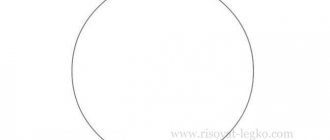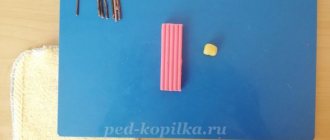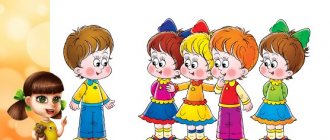Exercises for children to become familiar with dry sand
Exercise “Good afternoon, Grain of Sand”
GOAL: relieve tension.
Progress of the exercise:
The psychologist, on behalf of Peshinka, asks the children to “get acquainted with the sand,” that is, to touch the sand in various ways. Every child:
- touches the sand alternately with the fingers of one hand, then the other, then with all fingers at the same time;
- at first lightly, then with tension he clenches his fists with sand, after which he slowly pours it into the sandbox;
- touches the sand with the entire palm - the inside, then the outside;
- rubs sand between fingers and palms.
The teacher asks children of senior preschool age to talk about their feelings: “warm - cold”, “pleasant - unpleasant”.
Exercise “Sand Rain”
TARGET:
- learn to regulate muscle tension and relaxation;
- introduce the properties of dry sand.
Progress of the exercise:
The teacher speaks on behalf of Sandy: “In my country there may be an unusual rain of sand and a sandy wind blowing. It is very nice. See how it happens. (Shows.) You yourself can make such rain and wind.” Children slowly and then quickly pour sand from their fist into the sandbox, onto the palm of an adult, onto their palms.
A grain of sand invites each child to close their eyes and place their palm on the sand, spreading their fingers. An adult sprinkles sand on a finger, and the child names this finger. Then they change roles.
Breathing exercise “Sandy wind”
PURPOSE: to teach the child to regulate the inhalation and exhalation of air.
Progress of the exercise:
The teacher invites the children to say pleasant wishes to their friends-grains of sand, to give sincere wishes to the sandy country, “blowing” them into the sand. Children learn to blow through a cocktail straw rather than sucking sand into it.
Children of older preschool age can be asked to blow ditches on the surface of the sand. This exercise can be combined with aromatherapy, when a child, drawing air into his lungs, inhales essential oils sprayed in the room, and when exhaling, he lightly blows sand onto his palms, blowing grains of sand into the sandbox.
Exercise “Unusual traces”
GOAL: to develop tactile sensations and imagination.
Progress of the exercise:
The teacher offers children imitative exercises that leave footprints in the sand, for example:
“The little bears are coming” - the child presses the sand with his fists and palms;
“Hares are jumping” - the child hits the surface of the sand with his fingertips, moving in different directions;
“Snakes are crawling” - the child, with relaxed or tense fingers, leaves a wavy mark on the surface of the sand in different directions;
“Bugs and spiders are running” - the child moves all his fingers, imitating the movements of insects (you can completely immerse your hands in the sand, your hands meet - “bugs say hello”);
“Krakozyabra” - children make different prints in the sand, coming up with names for the fantastic animals that left these footprints. After the lesson, you can draw a fictional fantasy creature and make it an inhabitant of a sandy country.
Didactic game exercises
Exercise “Patterns on the sand”
GOAL: consolidate knowledge about sensory standards and patterns.
Progress of the exercise:
The psychologist draws with his finger, the edge of his palm, or a brush in the upper part of the sandbox various geometric shapes familiar to children, simple or complex patterns - straight and wavy paths, fences, steps, etc. - and invites the child to draw the same pattern at the bottom of the sandbox, or to continue the adult’s pattern. Alternatively, the teacher can draw a certain pattern on the board and offer to draw it in the sand.
Children can create patterns in the sand and lay them out in a given or planned sequence, just like certain objects, say, stones, acorns, large buttons, and the like.
The teacher addresses each child on behalf of the Sand: “Today you and I will decorate our sand house. Look at the patterns you can draw in the sand. Draw just like me. Come up with your own pattern, drawing. The pattern should consist of rings at the top, and triangles at the bottom.”
Game exercise “Creating a forest and its inhabitants”
TARGET:
- develop tactile sensations, auditory memory, creativity
— expand and clarify children’s knowledge about the forest and its inhabitants.
Progress of the exercise:
The teacher addresses the child on behalf of a grain of sand: “Today you will turn into a little wizard who can create anything, say, a forest with its inhabitants. But to make the magic happen, you must say the magic words: “Firs, birches, boletus trees.” You must close your eyes. (The child closes his eyes. At this time, the teacher “plants” the sand with trees, flowers, mushrooms.) Open your eyes and look - how good and interesting everything turned out!”
The teacher draws the child’s attention to the fact that the Grain of Sand has wonderful helpers - fingers “Ask your fingers to help you with magic. (The teacher squeezes and unclenches his fingers, “walks” with them on the sand, digs holes, the child does the same himself.) Now say the same magic words as the Grain of Sand, and with the help of magic create another forest. Remember what animals live in the forest? Invite them into your forest."
If the child said the “magic words” incorrectly, the adult hides some of the toys. The child repeats the magic words again. After “planting the forest,” the teacher introduces a few more words related to the plot for memorization. For example: names of trees, flowers, mushrooms, etc.
Note: in other exercises, the task is the same as in the first exercise. Only the characters, the methods of creating the landscape and the “magic words” change. The number and complexity of words that children are able to remember should be selected in accordance with the age of the children. It is advisable to select the topic of construction so that it corresponds to the topic of the lesson that the teacher conducts in the group.
Indicative topics for the exercises:
— We create the sea, rivers, lakes and their inhabitants;
— We create a city and its inhabitants;
— We create the village and its inhabitants;
— Space travel, meeting with aliens.
One of the objectives of the exercise “Space travel, meeting aliens” is to develop imagination and fantasy. Therefore, the teacher encourages any manifestations of fantasy that reveal the child’s inner world. This exercise is diagnostic in nature when working with shy and aggressive children.
Game exercise “We are going to visit”
TARGET:
- learn to navigate on a sandy surface;
- develop spatial concepts;
Progress of the exercise:
The teacher addresses the child on behalf of Sandy: “We are going to visit the bunny. Where does the bunny live? (The bunny lives in the forest.) Why? (Because it is a wild animal.) In which corner of the sandbox is the forest growing? (In the upper right.) Who else lives in the forest? (Other animals). How many are there? (Count pictures of wild animals.) Who is the bunny's friends? (With a squirrel and a hedgehog.) Who is the bunny afraid of? (Wolf and fox.) Who lives next to the bunny? (His friends.) What did the bunny treat us to? (Carrots and cabbage.) What do we wish for the bunny? (Children express their wishes).”
Through play, while visiting different animals, the teacher forms in children spatial concepts (or reinforces the concept) “up - down”, “right - left”, “above - below”, “middle”, “corner”. The child, at the direction of the adult, “walks,” “jumps,” and “crawls” along the sand with his fingers, depicting different characters.
Games and exercises for immersing hands in the sand
Some children are afraid of completely immersing their hands in the sand. Such children do not participate in games and exercises of immersing their hands in the sand. For other children, playing on the surface of the sand and playing with diving alternates depending on their desire.
Game exercise “Secret tasks of the mole”
TARGET:
- develop tactile sensations, the ability to relax;
- increase interest in playing with sand;
— expand children’s knowledge about those who live underground.
Progress of the exercise:
The teacher addresses the child on behalf of a grain of sand: “Today our hands will turn into moles. Like this. (The adult waves his hands and forms them into a “duck” shape, showing the child the eyes, nose and two teeth drawn on his wrists.) Do you want to turn your hands into moles? To do this, you need to help my mole complete a secret mission underground. (At the child’s request, the adult draws a mole on his wrists.) So? Are we diving? Look and do like my mole.”
The teacher immerses one hand in the sand, moves it, and draws the child’s attention to changes on the surface of the sand. Then he carefully digs out each finger.
Then the child does the same. After this, the children “unearth” each other’s hands. You can blow on the sand, use a feather, a stick, a brush, etc.
Alternatively, all actions can be performed with your eyes closed, look for the hands of your comrades in the sand, shake them - “the moles say hello.”
Game exercise "Sandy blind man's buff"
TARGET:
- develop tactile sensations, visual perception, imaginative thinking;
- expand and clarify children’s knowledge about fairy tales and fairy-tale characters;
- form voluntary behavior.
Progress of the exercise:
To play, you need to have laminated pictures with illustrations from different fairy tales and images of fairy-tale characters; you can make them yourself by covering bright pictures with tape. For sand therapy games with children, we use color pictures with clear images. At the initial stage - with the image of one object or a fairy-tale character with a gradual complication of the image depicted. For games with older preschoolers, you can use pictures with black and white or even silhouette images.
Before the exercise, the psychologist should recall with the child his favorite fairy tales and fairy-tale characters, talk about the reasons for positive and negative attitudes towards various characters.
The teacher addresses the child on behalf of a grain of sand: “Fairy tales and fairy-tale characters like to hide in the sand. Let's play sand blind man's buff with them. Close your eyes and say the magic words: “Look at the sand - a fairy tale will appear from the sand.” (The adult buries a picture with an illustration from a fairy tale familiar to the child in the sand, leaving a corner of the image visible.) Open your eyes, take a brush and start looking for a fairy tale in the sand. To avoid frightening the tale, unearth it slowly and carefully. You have already cleared away the sand from part of the picture. What kind of fairy tale do you think this is?”
The child gradually unearths the picture until he can name the fairy tale or fairy-tale characters. If the child cannot guess and name a fairy tale with picture elements, the teacher changes roles with the child. The child himself buries the picture in the sand, and then the adult digs it up and thinks out loud, analyzes what he saw, teaching the child how to act.
Game 1. Guess the emotion
Participants in the game think of any emotion or mood. All children and the leader stand around the sandbox. The first participant quietly tells the presenter the emotion he wished for and proceeds to show it.
Everyone must portray their emotion by manipulating sand.
For example: “sadness” - rain of sand, “anger” - sharp chaotic movements of the hands on the surface or in the depths of the sand, etc.
If none of the participants can guess the emotion, the presenter can help the person showing:
- turn on music that matches the desired mood,
- allow you to draw an emotion in the sand,
The one who guesses first is the next to show the hidden emotion.
Game 2. Good mood
This and the next game are best played on individual trays.
The presenter with the children remembers as many negative emotions as possible. Then each participant chooses “their” negative emotion and creates it in the sand. This could be a drawing in the sand, shapes or a name sculpted from sand (moistened with water or kinetic). After this, the leader helps the children remember positive emotions. It’s good if they turn out to be opposite, for example, “sadness” - “joy”, “hate” - “love”.
Then the participants begin to “conjure” and turn negative emotions into positive ones. If it's a drawing or writing in the sand, you can use cocktail straws to blow away the bad emotion (you need to blow very carefully so as not to get it in your eyes. The longer the straw, the better), and then draw a good emotion in its place.
If an emotion is a form sculpted from wet sand, then it is first broken, and then a new, positive emotion is molded in its place.
There is a more difficult version of the game. Children in a common sandbox create a whole world (country) of negative emotions. This may require natural materials, miniature figures of people, buildings, and animals. Then the participants in the game together destroy it and build a new world consisting of positive emotions and feelings.






